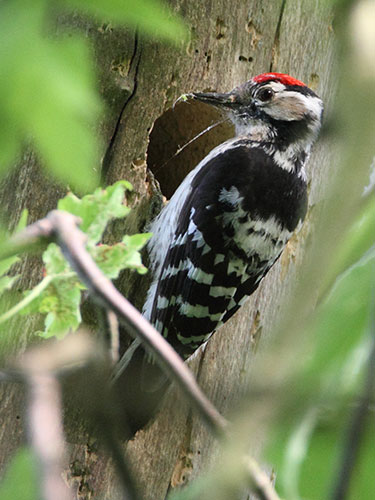


Lesser Spotted Woodpecker Dryobates minor
Photo: Phil Wallace ( www.birdmad.co.uk)
The Lesser Spotted Woodpecker Dryobates minor is one of a small set of extremely elusive and rather scarce woodland species which is challenging yet addictive to study. At 14-16.5cm in length, it the same size as a House Sparrow, making it diminutive compared to our two other resident woodpeckers, Great Spotted Dendrocopos major and Green Picus viridis.
This bird is not a long-distance migrant but has suffered similar population declines to species which take long and risky migrations, like Turtle Dove and Nightingale, with an 83% decline since 1970. Since 2010, records have been gathered by the Rare Breeding Birds Panel (RBBP), a dubious honour which applies to birds with a UK population of no more than 2,000 pairs.
Although a sedentary species, it is unusual in that it is only likely to be encountered at a specific time of year, late winter and early spring. The rest of the year, it really does melt away into the woodland and becomes all but impossible to detect. However, when the days are a little warmer and the first butterflies are emerging, until the leaves appear on the trees, it becomes rather easy to find in the right places.
At this time of year, both males and females drum regularly near the site they will excavate their nest, something they do anew each year. It is subtly different to the more familiar sound of drumming Great Spotted Woodpeckers, but the flat and relatively weak delivery, and longer duration, is noticeable with just a little experience. The Lesser Spotted Woodpecker’s advertising call is hard to miss, being a high-pitched ‘pii-pii-pii-pii...’ It is reminiscent of a Kestrel’s call but is of a much purer tone, somewhat higher pitched and tends to go on for longer, up to 15 notes.
With real luck and patience, pair bonding displays involving short flights on exaggerated wingbeats (‘butterfly flight’) and spread wings when settled can be observed. Males and females can be distinguished by the colour of the crown, red on males and white on females. Once the nest cavity has been excavated, a hollow which can be as deep as 18cm, between four and six white eggs are laid, which hatch after 11 or 12 days. The young fledge after a further 18 to 20 days.
The reasons behind the stark decline of Lesser Spotted Woodpecker have been uncertain, with theories including habitat fragmentation and pressure from the increasing Great Spotted Woodpecker, a generalist woodpecker which is able to take advantage of garden bird feeders. It has recently been shown that low breeding productivity is driving the population decline. Although no trends were found in nest survival during the egg stage or chick rearing, the number of young fledged has declined year-on-year, probably due to starvation of young.
The Woodpecker Network follows up sightings of Lesser Spotted Woodpeckers to monitor breeding success, sometimes using nest inspection cameras to get a rare glimpse at the goings on inside the nests of this fascinating bird, to learn more about the challenges faced by the species.
Please report sightings of Lesser Spotted Woodpecker via BirdTrack and to The Woodpecker Network, complete with a six-figure grid reference. Remember that Lesser Spotted Woodpecker sightings at any time of year are likely to relate to breeding pairs in the area and are worth following up in late winter and early spring.
David Campbell
Recorder, Sussex Ornithological Society
Every month it is our aim to highlight a species that is “in-season” and, although not necessarily rare or difficult to identify, has been highlighted by our local recording groups as being somewhat under-recorded and for which new records would therefore be welcomed.
If you or your recording group are aware of species such as this then please contact Bob Foreman.